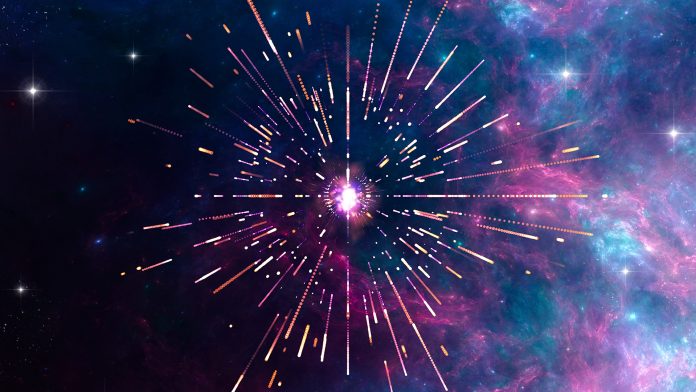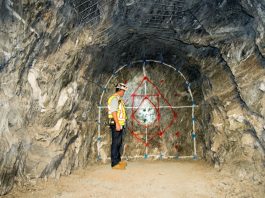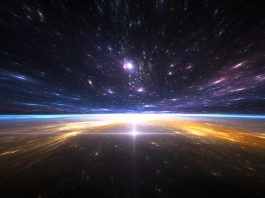Sowjanya Gollapinni details the major collaborations in neutrino research helping to answer the great mysteries of the Universe.
One of the most abundant particles in the Universe, neutrinos, are subatomic particles that have no electrical charge and a tiny mass. Despite their abundance, our knowledge of neutrinos is limited as their minimal interactions with matter make them very difficult to detect. Furthering neutrino research and enhancing our knowledge of these particles could have profound implications for our understanding of the Universe, by helping to answer several fundamental questions about the nature of matter. For this reason, many research organisations across the globe are pooling their resources and efforts into various experiments and programs dedicated to neutrino research.

Sowjanya Gollapinni is a Senior Scientist in the Physics division at the U.S. Department of Energy’s Los Alamos National Laboratory (LANL) in New Mexico, US, and is involved in many major experiments dedicated to studying neutrinos. To find out more about her work and the vast potential of these ghostly particles, The Innovation Platform Editor Georgie Purcell spoke to Gollapinni.
Can you start by explaining more about neutrino research? Why are neutrinos so elusive? What potential does neutrino research hold for our understanding of the Universe?
Neutrinos are all around us, but they are also ghostly and mysterious. Trillions of them pass through our bodies each second, but you are lucky if one neutrino interacts with you in your entire lifetime. Detecting and studying neutrinos is highly challenging due to their incredibly unsociable nature.
Neutrinos are excellent carriers of information from parts of the Universe that we don’t have access to, like bursting stars and black holes. For example, we learnt about what happens deep inside the Sun and why it shines by studying neutrinos.
Neutrinos have many bizarre properties. My favourite trait is that they can morph into different types as they travel long distances, which we refer to as ‘neutrino oscillations’. We know there are three types (or flavors) of neutrinos: electron, muon, and tau. If, for example, the Sun is emitting electron neutrinos, by the time they reach Earth, you may not see them as electron neutrinos, but as another flavor. This took a long time for us to understand, but the phenomena of neutrino oscillations are a great probe to try to shed light on the physics that we are not currently aware of.
We have been studying neutrinos for around a century now and, whilst we have learnt a lot, there is still much more we are yet to discover. For example, we do not know what neutrinos’ absolute masses are; which neutrino is the lightest or the heaviest; or if there are other types of neutrinos. Currently, we know there are three types, but there could be a fourth – often referred to as a ‘sterile neutrino’. In addition, we do not know if a neutrino is its own antiparticle or how neutrinos and antineutrinos behave. We are building experiments now to study properties of neutrinos and, by doing so, we are already learning a lot about the Universe, which we couldn’t with other particles. Studying neutrinos can open a doorway to some of the deepest and darkest secrets of the Universe.
When neutrinos were first predicted, we thought they were massless, but in more recent years we have discovered that they do have mass – albeit, very tiny. This discovery has many profound implications as it enables us to answer some of the most sought-after questions in physics, such as ‘why do we live in a matter-dominated Universe?’.
According to the Big Bang, when the Universe was formed, there would be equal amounts of matter and antimatter. As the Universe cooled down, the matter and antimatter would annihilate, producing just light. But that did not happen, because we are here. Therefore, something avoided that cancellation of matter and antimatter. We do not know what caused that imbalance and answering that basically answers the question of why we exist at all. One of the largest open questions now is whether or not neutrinos violate charge parity (CP) symmetry, i.e. a difference between how particles and their anti-particles interact. A matter-dominated Universe requires a source of CP violation, but no source of enough CP violation has been found so far. The only place we have not yet looked to answer this question is neutrinos.
There is great potential for neutrinos to improve our understanding of the Universe. One example is the puzzle of dark matter. Visible matter or the matter that makes up us and the things around us is only about 5%, and everything else is dark matter and dark energy. We know dark matter exists, but we do not know what it is made up of. A fourth neutrino could be a promising candidate for dark matter.
What are the current focuses of your research at LANL?
There are several different categories of neutrino experiments. Some are dedicated to measuring the absolute masses of neutrinos, such as the KArlsruhe TRItium Neutrino (KATRIN) experiment. There are also experiments to determine if the neutrino is its own antiparticle, which we refer to as ‘double beta decay experiments’. Then there are experiments that we categorise as ‘oscillation experiments’, which is what I am primarily involved in.
Neutrino oscillation experiments are typically designed with a near detector and a far detector. By putting a detector very close to a beam source, it is possible to study neutrinos and their flavors before they start travelling long distances. Putting another detector further away allows for the study of neutrinos after they have oscillated travelling this long path.
Depending on how far away the detector is from the beam, they are categorised further into short-baseline experiments. Here, the distance from the neutrino beam to the detector is typically 1km or less. The other category is long-baseline experiments, where the distance between the neutrino source and the detector is around 1,000km.
A lot of thought goes into where we choose to place our detectors from the beam, because that impacts the type of physics we want to extract. For example, at the short-baseline experiments, we are mainly searching for sterile neutrinos. In the long-baseline experiments, the primary goal is to understand which neutrino is the heaviest and the lightest, and to understand why we live in a matter-dominated Universe. Irrespective of the type of neutrino experiment, we are always looking for new physics phenomena based on theoretical predictions or past anomalies observed.
I am involved in both short-baseline and long-baseline experiments. I participate in the MicroBooNE short-baseline experiment and the Short-Baseline Neutrino (SBN) Program, both located at Fermilab in the US. I do my research from LANL but the experiments are at Fermilab. The Short-Baseline Neutrino Program is a three-detector program, where detectors are placed along the same beamline but at different distances. The probability of oscillations is different at different locations, helping to maximise the physics extracted when looking for sterile neutrinos or other new physics.
In the case of long-baseline experiments, I am involved in the Deep Underground Neutrino Experiment (DUNE), which is the holy grail for particle physics. In DUNE, I am involved in understanding the mass hierarchy question with neutrinos, and also understanding the charge-parity violation question that can help us understand about the matter abundance in the Universe. We foresee DUNE to start taking data in the early 2030s, but we are currently building prototype DUNE detectors at the CERN laboratory in Switzerland.
The scale of DUNE itself is unprecedented – it is like building a ship in a bottle. The beam from Fermilab travels 800 miles to the Sanford Underground Research Facility (SURF) in South Dakota. The DUNE far detector is located one mile underground at SURF. DUNE is roughly the size of a football stadium, and that is just one part of it – in total, we need to build four such modules deep underground. The size of DUNE makes it impossible to build it on the surface and crane it down, which is why it has to be built underground.
I am involved actively in the DUNE prototype experiments, known as ‘protoDUNEs’, at CERN. Although they are prototypes, these are by no means small experiments, and each detector is roughly the size of a four-storey building. Here, particle beams interact with the argon nuclei and we are validating the designs developed for DUNE, as well as trying to understand how neutrinos interact with liquid argon and the complicated nuclear effects that are created around those interactions.
All these experiments use the novel Liquid Argon Time Projection Chamber (LArTPC) technology. It is only recently that this technology has been applied for neutrinos. Over the last 15 years, there has been enormous progress in the R&D of these detectors, and building large-scale detectors to demonstrate that this is a viable technology for us. In the US, MicroBooNE is the first demonstration of a 100-ton scale LArTPC. I do a lot of detector development and instrumentation at LANL. For DUNE, I am heavily involved in developing calibration instrumentation, which will help us to better understand the signals we detect and allow us to extract physics.
LANL has a great facility called the Los Alamos Neutron Science Center (LANSCE), which presents lots of opportunities. Alongside the neutrino interaction measurements with liquid argon that I do, I am also developing experiments that I can put in the neutron beam at LANSCE to study how well DUNE can detect neutrons and their importance for neutrino oscillation measurements.
How do you collaborate with researchers from other organisations to further neutrino research? What role does international collaboration play in your work?
Although the particles we study are so tiny, the detectors we build are gigantic. It is, therefore, impossible for a single person or a single institute to build an experiment to collect the data and analyse it. All our experiments have collaborator numbers ranging from a few hundred to a few thousand. MicroBooNE, for example, has around 200 collaborators, and DUNE has more than 1,400.
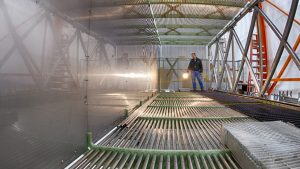
Almost all of the big particle physics experiments these days are global collaborations. The importance of international collaboration comes in many forms. The US, for example, may not have all the resources to complete all aspects of DUNE, and this is where foreign partners can bring valuable resources and infrastructure to the project. On DUNE, there are over 35 countries participating: UK, Spain, Portugal, France, Canada, Colombia, and Switzerland to name a few. The CERN lab in Europe is also one of our major partners, bringing significant resources into DUNE such as the 60m-long cryostats for the far detector. Similarly in the UK, there are around 20 institutes collaborating on DUNE. One of the main components for DUNE are the anode plane assemblies (APAs), which collect our signal in the detectors. The UK is one of the major collaborators providing the resources for APA production for DUNE, through their funding agencies and highly capable labs.
Additionally, the diversity, and both physics and technical expertise are something that we mutually benefit from by being part of international collaborations. To do something as challenging as DUNE, we need to utilise all the global expertise that is available out there.
I collaborate currently with many institutes. My standing collaborators are all the host labs, which are Fermilab, CERN, and SURF. There are many members there with whom I closely interact with to carry out my experimental work. On MicroBooNE, for example, I am working primarily with Columbia University on various analyses trying to solve sterile neutrino puzzles. On DUNE, I collaborate with the Laboratory of Instrumentation and Experimental Physics (LIP) in Portugal. Within the US, I collaborate with the University of Hawaii, Kansas State University, South Dakota School of Mines and Technology, University of California, Davis, and many more.
What progress have you made in your work in recent years? What have been the standout findings?
I will start with the short-baseline experiments I am involved in, which is primarily the MicroBooNE experiment and the Short-Baseline Neutrino Program.
Recent years have been extremely productive and rewarding for me as a collaborator, but also for our neutrino program at LANL in general. In neutrino physics, we started seeing some anomalies over the past two decades. This started with the Liquid Scintillator Neutrino Detector (LSND) experiment that was run at LANL, where we saw an excess of data over what one would expect theoretically. The possibility of a fourth, sterile neutrino could be a reason for this. There was also the MiniBooNE experiment at Fermilab, which ran for almost 17 years, built to understand the LSND anomaly. MiniBooNE did not address the LSND anomaly because it did not see the data excess in the same energy region as LSND, but it saw a data excess in a different region than LSND, leaving not one but two anomalies to understand. In order to understand the MiniBooNE anomaly, we built MicroBooNE.
We are also building the short-baseline program at Fermilab, ICARUS and the Short-Baseline Near Detector, in order to collectively understand the existing hints for sterile neutrinos, and make definitive conclusions. MicroBooNE started taking data in 2015 and continued until last year. Over the past five years, we have been actively analysing data, and my team is involved in understanding if the MiniBooNE anomaly was actually caused by electrons or photons, the light particles. If the humble photon is indeed at the centre of the puzzle, then we are looking at a new physics process or a particle. We released our first results from MicroBooNE last year. We have only analysed half of the data and more work needs to be done to try to fit to theoretical models and interpret results. There are an infinite number of possibilities to explore, but those first results are a great milestone for MicroBooNE and the SBN program as a whole. LANL had a leading role in getting those first results out.
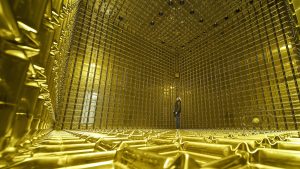
On DUNE, the focus has largely been on technical demonstration and instrumentation. I co-led the overarching calibration strategy for DUNE. DUNE has many moving parts and the length of one DUNE far detector is about 60m. DUNE is highly segmented and the detector moves in the cold liquid argon. For example, there are 150 APAs in a single DUNE far detector. This is where the importance of calibration comes in, as you want to understand the environment within the detector and that the detector response is uniform. I am developing a laser-based calibration system for DUNE that uses Class-IV laser beams and my most recent trip to CERN was to install those systems on protoDUNE, and to start testing them.
What do you hope to achieve in 2023 and beyond?
With the work being done at the short-baseline experiments around the world, I foresee 2023 to be a very significant year for the neutrino physics community, and personally to me because we are now analysing the full set of MicroBooNE data.
MicroBooNE receives neutrino beam from two beamlines at Fermilab. One is a Booster Neutrino Beam (BNB), whilst the other is Neutrinos at the Main Injector, known as the NuMI beam. Over the next year, in addition to analysing the full MicroBooNE dataset, we also plan to analyse the NuMI data that has a different composition of the beam compared to the BNB which will help us in further honing down on the sterile neutrino question and other new physics phenomena we are exploring. In parallel to this, a lot of work is being done on the theory and phenomenology side to understand what we are seeing with the MicroBooNE data.
On DUNE, demonstrating the ProtoDUNEs with the competence designed for DUNE will be a major milestone, in addition to carrying out physics that will help us calibrate the detectors and understand how neutrinos interact with argon.
Beyond 2023, all three detectors of the Fermilab SBN program would have been commissioned and started collecting data. The ICARUS and Short-Baseline Near Detector (SBND) are the near and far detectors in the SBN program. It will be very exciting to learn what we will find from the joint analysis of the SBN detector data.
For long-baseline physics and the DUNE experiment, we will start construction and installation of the DUNE far detector at SURF starting 2024. That will continue for three to four years, by which time the neutrino beam upgrades to megawatt scale would have progressed significantly at Fermilab. It is very exciting that we will start data-taking with DUNE in the early 2030s. The moment DUNE turns on, even if there is no neutrino beam, it becomes a supernova detector. DUNE has enormous potential to detect supernovae and other astronomical phenomena and I expect DUNE to be the next big thing beyond 2023.
Although the short-baseline and the long-baseline experiments focus on different questions, they are not really separate. For example, what we find with MicroBooNE and the short baseline experiments can have a significant impact on how we extract physics in DUNE and the planning of future neutrino experiments. To explain, so far, when we plan our long baseline physics, studying neutrino oscillations, it is with the assumption that there are three neutrino flavors and not more. If sterile neutrinos were discovered, we would have to consider oscillations from not just the standard flavors, but also the sterile flavor. Therefore, that would impact what DUNE would see when the neutrinos start oscillating from Fermilab as they travel to DUNE.
Overall, all these experiments are like different pieces of the same puzzle and will help in completing the story of neutrinos. The picture that emerges from this when we have figured out this whole puzzle will be groundbreaking and could change the way we think about our Universe.
Sowjanya Gollapinni
Senior Scientist, Physics
Los Alamos National Laboratory (LANL)
sowjanya@lanl.gov
https://www.lanl.gov/
https://www.linkedin.com/in/sowjanya-gollapinni-09611a7a/
Please note, this article will also appear in the thirteenth edition of our quarterly publication.

